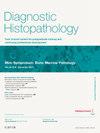Novel anal lesions not to overlook
引用次数: 0
Abstract
Although the anal canal comprises only a small portion of the gastrointestinal tract, it can be affected by a variety of inflammatory and neoplastic processes. Inflammation of the anal mucosa can result from trauma, infections, and inflammatory bowel disease. Non-neoplastic lesions such as inflammatory cloacogenic polyps, hemorrhoids, and fibroepithelial polyps are relatively common, but may harbor other lesions, necessitating careful histologic assessment. The anogenital mammary-like glands and perianal skin can give rise to neoplasms including hidradenoma papilliferum and basal cell carcinoma. Human papillomavirus (HPV) is an important cause of squamous dysplasia and squamous cell carcinoma, as well as several recently described non-squamous neoplasms. Adenocarcinoma of the anus is divided into intestinal, anal gland, and fistula-associated types, which have unique morphologic features. Anal Paget's disease can occur as a primary neoplasm, or may be secondary to underlying adenocarcinoma. Less common neoplasms of the anus include neuroendocrine neoplasms, mucosal melanoma, and mesenchymal neoplasms such as granular cell tumor and gastrointestinal stromal tumor (GIST). This review will cover the clinical presentation, key histologic features, differential diagnosis, and relevant ancillary studies to consider for each condition. Recognition of inflammatory and neoplastic diseases of the anus is essential to guide appropriate treatment of patients.
新的肛门病变不容忽视
虽然肛管只占胃肠道的一小部分,但它可以受到各种炎症和肿瘤过程的影响。肛门粘膜的炎症可由外伤、感染和炎症性肠病引起。非肿瘤性病变,如炎性阴囊性息肉、痔疮和纤维上皮性息肉相对常见,但可能存在其他病变,需要仔细的组织学评估。肛门生殖器乳腺样腺和肛周皮肤可产生包括乳头状腺瘤和基底细胞癌在内的肿瘤。人乳头瘤病毒(HPV)是鳞状异常增生和鳞状细胞癌的重要原因,以及最近描述的几种非鳞状肿瘤。肛门腺癌分为肠型、肛门腺型和瘘管相关型,它们具有独特的形态特征。肛门佩吉特病可以作为原发性肿瘤发生,也可以继发于潜在的腺癌。不太常见的肛门肿瘤包括神经内分泌肿瘤、粘膜黑色素瘤和间质肿瘤,如颗粒细胞瘤和胃肠道间质瘤(GIST)。这篇综述将涵盖临床表现,关键的组织学特征,鉴别诊断和相关的辅助研究,以考虑每个条件。识别肛门的炎症性和肿瘤性疾病对于指导患者的适当治疗至关重要。
本文章由计算机程序翻译,如有差异,请以英文原文为准。
求助全文
约1分钟内获得全文
求助全文
来源期刊

Diagnostic Histopathology
Medicine-Pathology and Forensic Medicine
CiteScore
1.30
自引率
0.00%
发文量
64
期刊介绍:
This monthly review journal aims to provide the practising diagnostic pathologist and trainee pathologist with up-to-date reviews on histopathology and cytology and related technical advances. Each issue contains invited articles on a variety of topics from experts in the field and includes a mini-symposium exploring one subject in greater depth. Articles consist of system-based, disease-based reviews and advances in technology. They update the readers on day-to-day diagnostic work and keep them informed of important new developments. An additional feature is the short section devoted to hypotheses; these have been refereed. There is also a correspondence section.
 求助内容:
求助内容: 应助结果提醒方式:
应助结果提醒方式:


